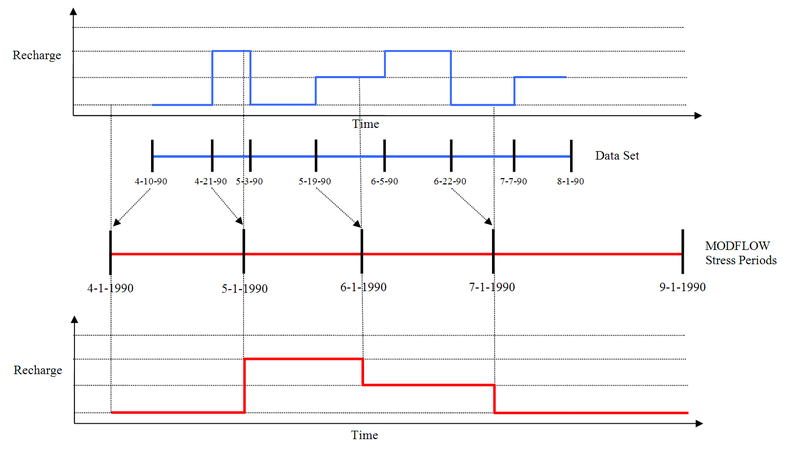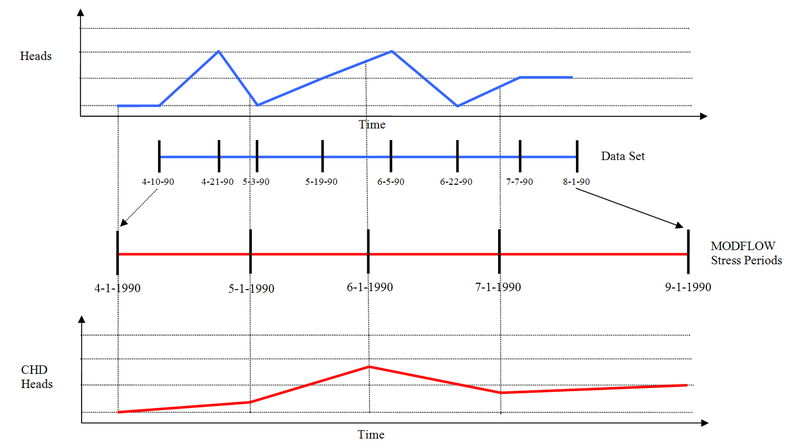GMS:Interpolate to MODFLOW Layers: Difference between revisions
(No difference)
|
Revision as of 23:04, 24 June 2011
| This contains information about functionality available starting at GMS version 8.0. The content may not apply to other versions. |
In this dialog the user can select various 2D scatter point data sets and associate them with MODFLOW input data. GMS will then interpolate from the 2D scatter point data to the MODFLOW input data. This is often useful to define the layer elevations of a MODFLOW model. Click here for more information on MODFLOW layer elevations.
The user associates 2D scatter point data with MODFLOW data by selecting a data set in the list on the left of the dialog and selecting an item from the MODFLOW data list on the right and then selecting the Map button. The association between the data sets and the MODFLOW data is shown in the spread sheet labeled Data set => MODFLOW data.
The MODFLOW data group box contains options to allow the user to pick which MODFLOW data they would like to interpolate to. Elevations refers to the top and bottom elevations of the 3D grid. Heads refers to the starting heads. Flow package data refers to the various input arrays for the LPF or BCF packages (HK, VK...). Recharge refers to the recharge rate specified in the RCH package. CHD BCs refers to the starting and ending heads associated with existing CHD boundary conditions in the MODFLOW model.
The Automap button will try to automatically map the data sets to the MODFLOW data by matching names and layer numbers. The Unmap button is used unmap the selected item(s) in the spread sheet. The Unmap All button is self explanatory.
The Interpolation Options button will bring up the 2D Interpolation Options dialog.
Transient Interpolation
If a 2D scatter point data set is transient and the user is interpolating to MODFLOW data that does not vary with time then the user will select a time step from that data set to interpolate to the MODFLOW data. When the user has selected a time step the Apply Selected Time To All Transient Data Sets button will undim. This button allows the user to set the selected time of all of the transient data sets to be the same as the currently selected time.
If the current MODFLOW model is transient and the user is interpolating to Recharge then interpolation will occur for each stress period defined in the MODFLOW model. For a particular stress period, the closest data set time step whose time is less than the beginning of the stress period is used. Figure 1 illustrates this process.
If the current MODFLOW model is transient and the user is interpolating to CHD BCs then interpolation will occur at the beginning and the end of each stress period (because a start head and an end head are specified for each CHD BC). If there is no data set time step that matches the beginning or the end of the stress period then GMS will linearly interpolate between data set time steps. Figure 2 illustrates this process.
GMS – Groundwater Modeling System | ||
|---|---|---|
| Modules: | 2D Grid • 2D Mesh • 2D Scatter Point • 3D Grid • 3D Mesh • 3D Scatter Point • Boreholes • GIS • Map • Solid • TINs • UGrids | |
| Models: | FEFLOW • FEMWATER • HydroGeoSphere • MODAEM • MODFLOW • MODPATH • mod-PATH3DU • MT3DMS • MT3D-USGS • PEST • PHT3D • RT3D • SEAM3D • SEAWAT • SEEP2D • T-PROGS • ZONEBUDGET | |
| Aquaveo | ||

